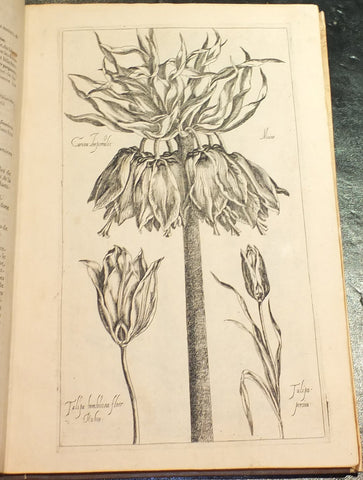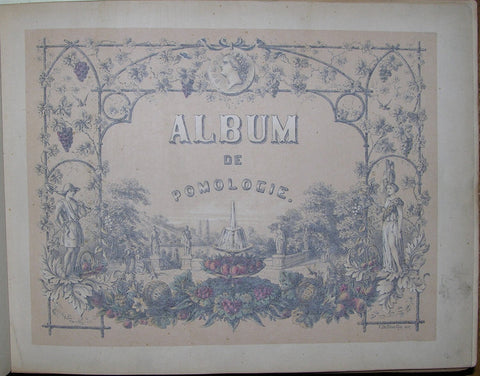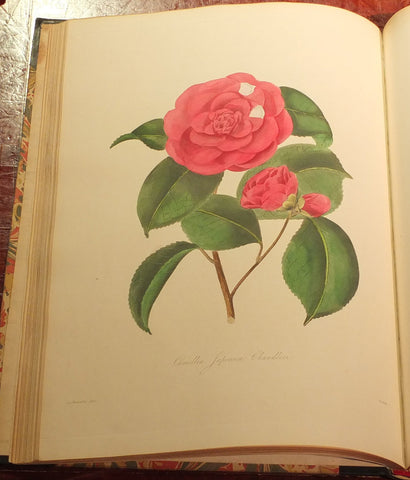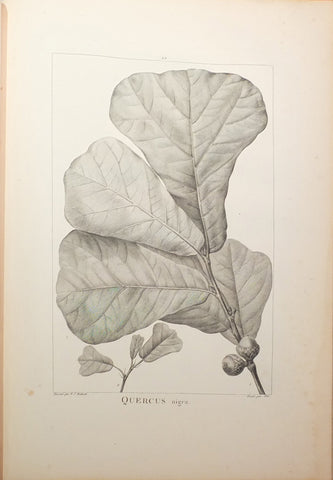Pierre Vallet (CA 1575-1657), Le Jardin du Roy Tres Chrestien Loys XIII
Pierre Vallet (CA 1575-1657)
Le Jardin du Roy Tres Chrestien Loys XIII
Paris: Pierre Mariette, 1623
Folio (13 2/8 x 9 inches). Etched architectural title-page with figures of Clusius and de L'Obel flanking a view of a formal garden with glass-houses beyond, engraved portrait of Vallet (lacks portrait of Robin) and 90 etched and engraved plates (upper right blank corner of most plates with discreet early repair). 19th-century vellum with gilt lettered red morocco lettering-piece on the spine.
Second edition, with 17 additional engraved plates. According to Blunt this is the first important florilegium and "a work of great beauty." At the beginning of the 17th century Marie de' Medici's great passion for flowers and plants set the fashion for floral themes at the French court. Le Jardin du Roi is Pierre Vallet's hommage to the queen, executed in part to provide patterns for embroideries, and in part to document some of the exotic species bought back from Spain and the islands off the coast of Guinea by Jean Robin the younger. Vallet, born in Orlains about 1575, moved to Paris where he worked as an engraver. He was appointed to the court of Henri IV as brodeur ordinaire de Sa Majestee and, later, vallet de chambre du roy. As engraver he produced illustrations for 'Touffe de Fleurs' (1601), 'Aventures amoureuses de Thaeagaene et Chariclée' (1613) and 'La Symbole de Nices' (1642). In Paris he met Jean Robin, who directed the Royal Gardens of the Louvre for Henri III, Henri IV and Louis XIII. Tournefort refers to Robin as the most celebrated botanist of his time and Linnaeus named the locust tree (Robinia) after him. Vallet and Robin collaborated on several works, such as 'Catalogus Stirpium...quae Lutetiae coluntur' (1601) and 'Histoire des Plantes aromatiques' (1619), but their masterpiece is certainly 'Le Jardin du Roy'. The plates are all etched but most also include engraved highlights. Their naturalism, which set new standards for natural history illustration, together with the novel form of the title ensured that the work met with considerable success, so much so that it was widely copied and adapted: some of Vallet's plates were directly copied by Johann Theodor de Bry in 'Florilegium Novum' (1611), by Emanuel Sweert in 1612 and by Friderico Barbette in 'Florilegium Novum' (1641). Marie de Medici (1573-1642), daughter of the Grand Duke Francis I of Tuscany and the Archduchess Joan of Austria, married Henry IV of France in 1600. In 1610 Marie was crowned Queen of France and appointed regent, with a council of fifteen, while her husband prepared for war with Germany and Spain. A day after her coronation Henri IV was assassinated, and so Marie's regency on behalf of her young son Louis XIII, began in earnest. With the support of Rhichelieu she established her household at Blois. Marie's regency was marked by opulence: the construction and furnishing of the Palais du Luxembourg, which she referred to as her "Palais Médicis", formed her major artistic project during her regency. The site was purchased in 1612 and construction began in 1615, to designs of Salomon de Brosse. Her court painter was Peter Paul Rubens. Her physician in Italy was Elijah Montalto. And, by a constant struggle for power between the Catholics and Protestant factions.
"After 1617, Maria de' Medici lived, with many vicissitudes, a life full of intrigue, which she sometimes carried to conspiracy. Escaping from Blois, 22 Feb., 1619, she made her way into Angoulême and obtained from Luynes the government of Anjou, which became a rallying-point for malcontents. The troops who supported her met those of the king at Les Ponts de Cé and were beaten (August, 1620). On the death of Luynes (15 December, 1621), she regained some of her influence; she caused Richelieu to be admitted to the council (1624), and was even entrusted with the regency during the war in Italy. But as Richelieu's hostility to Spain became more marked, she sought his dismissal. Allying herself with Gaston d'Orléans, she once — "the Day of the Dupes", 12 November, 1630 — thought herself successful in making Louis dismiss the cardinal. She was mistaken. Banished to Compiègne in February, 1631, she vainly endeavoured to obtain admission to the stronghold of La Capelle, whence she might have dictated terms to the king. At last she went into exile, to wait for the triumph of Gaston d'Orléans; but Gaston was beaten, and Maria de' Medici never more set foot in France. From 1631 to 1638 she spent her time in the Low Countries, sending across the French frontier manifestos which no one read. After that, taking refuge in England (1638-41) with her son-in-law Charles I, she was as a Catholic an object of suspicion to the Protestants of that country. Last of all, she betook herself to Germany, where she died, a helpless onlooker at the triumph of that foreign policy of Richelieu which was the exact opposite of what she had followed during her regency. The haughty queen, whose luxury and splendour had been blazoned in Rubens's immense canvases, possessed but a moderate fortune at the time of her death" (Catholic Encyclopedia online). .Dunthorne, p.253; Hunt 187; Nissen BBI 2039; Oak Spring Flora 8.
We Also Recommend




















